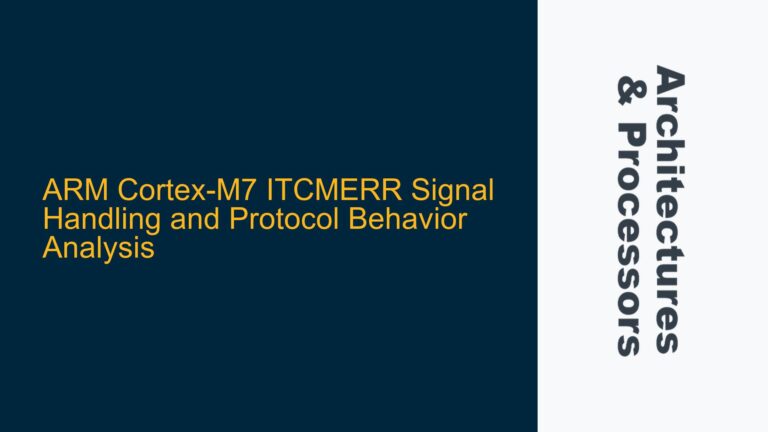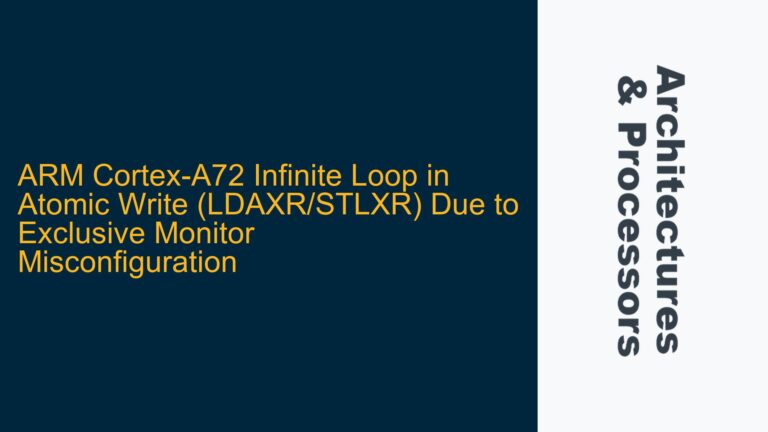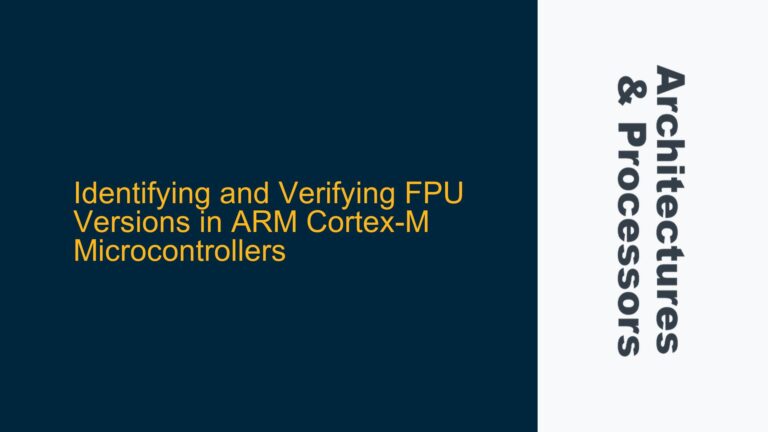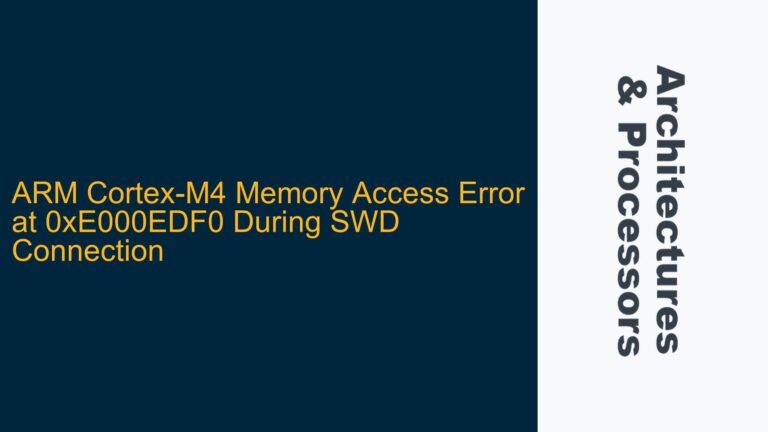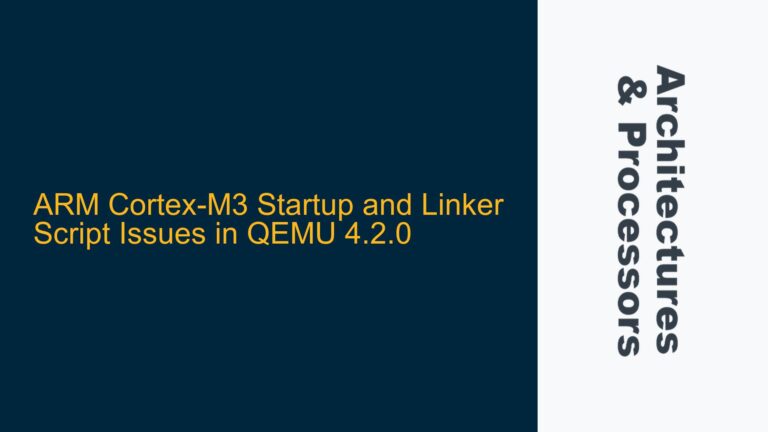ARMv7-M HardFault Triggered by Instruction Access Violation During Signal Handler Execution
The core issue revolves around a HardFault occurring when returning from a memory fault (MemFault) handler and attempting to execute a signal handler in an ARMv7-M architecture. The fault manifests as an instruction access violation (CFAULT = 0x1) with a "FORCED" HardFault (HFAULT = 0x40000000). This indicates that the processor is unable to execute the next instruction after returning from the MemFault handler, specifically when transitioning to the signal handler (up_sigdeliver). The fault is further characterized by the following register states at the time of the fault:
- LR (Link Register): 0xFFFFFFF9 (indicating a return to Thread mode with MSP)
- PC (Program Counter): 0x8161EF0 (pointing to
up_sigdeliver) - xPSR: 0x1000000 (indicating Thumb state)
- MSP (Main Stack Pointer): 0xC03275E8
- PSP (Process Stack Pointer): 0xC03276B8
- CONTROL Register: 0x3 (indicating Thread mode with MSP and unprivileged execution)
The fault occurs despite the MemFault handler attempting to acknowledge the fault by writing to the Configurable Fault Status Register (CFSR) at address 0xE000ED28. This suggests that the root cause lies in improper handling of the exception return mechanism or incorrect stack manipulation during the transition from the MemFault handler to the signal handler.
Misconfigured Exception Return Mechanism and Stack Corruption
The HardFault is likely caused by one or more of the following issues:
-
Incorrect Exception Return Address in LR: The Link Register (LR) value of 0xFFFFFFF9 indicates a return to Thread mode using the Main Stack Pointer (MSP). However, the signal handler (
up_sigdeliver) is being executed in an unprivileged state (CONTROL register = 0x3), which may conflict with the stack pointer configuration. If the stack pointer (MSP or PSP) is not correctly set up for the signal handler, it can lead to an instruction access violation. -
Improper Acknowledgment of MemFault: The MemFault handler attempts to acknowledge the fault by writing to the CFSR register. However, the code snippet provided shows a potential issue:
uint32_t cfsr = getreg32(NVIC_CFAULTS); /* NVIC_CFAULTS = 0xe000ed28 */ uint32_t *mfsr = (uintptr_t) NVIC_CFAULTS; *mfsr |= cfsr; /* Acknowledge interrupt */Writing back the same value to the CFSR register does not clear the fault bits. Instead, the fault bits must be cleared by writing a 1 to the corresponding bit positions. For example, if the CFSR value is 0x1 (instruction access violation), the correct acknowledgment would be:
*mfsr = 0x1; /* Clear the instruction access violation bit */ -
Stack Corruption During Exception Handling: The transition from the MemFault handler to the signal handler involves saving and restoring the processor state on the stack. If the stack is corrupted or improperly aligned, it can lead to an invalid return address or incorrect instruction fetch, triggering a HardFault.
-
Unprivileged Execution of Signal Handler: The CONTROL register value of 0x3 indicates that the signal handler is executing in unprivileged Thread mode. If the signal handler attempts to access privileged resources or execute privileged instructions, it can result in a HardFault.
Resolving HardFault by Correcting Exception Handling and Stack Management
To resolve the HardFault issue, follow these detailed steps:
-
Clear Fault Bits Correctly in MemFault Handler:
Modify the MemFault handler to properly clear the fault bits in the CFSR register. For example:uint32_t cfsr = getreg32(NVIC_CFAULTS); /* Read CFSR */ putreg32(cfsr, NVIC_CFAULTS); /* Clear fault bits by writing 1 to each bit */This ensures that the fault condition is acknowledged and does not persist.
-
Verify Exception Return Mechanism:
Ensure that the exception return mechanism is correctly configured. The LR value of 0xFFFFFFF9 indicates a return to Thread mode using MSP. Verify that the stack pointer (MSP) is correctly set up for the signal handler. If the signal handler requires the use of PSP, modify the LR value accordingly (e.g., 0xFFFFFFFD for Thread mode with PSP). -
Check Stack Alignment and Integrity:
Verify that the stack is properly aligned to an 8-byte boundary, as required by the ARMv7-M architecture. Use the following code to check and align the stack pointer:msp = (uint32_t)((msp + 7) & ~0x7); /* Align MSP to 8 bytes */Additionally, inspect the stack contents to ensure that the saved registers and return address are not corrupted.
-
Ensure Privileged Execution of Signal Handler:
If the signal handler requires privileged access, modify the CONTROL register to switch to privileged mode before executing the handler. For example:__asm volatile ("MRS R0, CONTROL"); __asm volatile ("BIC R0, R0, #0x1"); /* Clear bit 0 to switch to privileged mode */ __asm volatile ("MSR CONTROL, R0"); __asm volatile ("ISB"); /* Instruction synchronization barrier */ -
Debugging with Registers and Fault Analysis:
Use the register values and fault status registers to diagnose the issue further. The following table summarizes the key registers and their implications:Register Value Implication LR 0xFFFFFFF9 Return to Thread mode with MSP PC 0x8161EF0 Address of up_sigdeliverxPSR 0x1000000 Thumb state MSP 0xC03275E8 Main Stack Pointer PSP 0xC03276B8 Process Stack Pointer CONTROL 0x3 Thread mode with MSP and unprivileged execution CFAULT 0x1 Instruction access violation HFAULT 0x40000000 FORCED HardFault Analyze the faulting instruction and memory access patterns to identify potential misconfigurations or access violations.
-
Implement Data Synchronization Barriers:
Ensure that data synchronization barriers (DSB) and instruction synchronization barriers (ISB) are used appropriately to prevent out-of-order execution and ensure proper memory access ordering. For example:__asm volatile ("DSB"); /* Ensure all memory accesses are complete */ __asm volatile ("ISB"); /* Ensure the instruction stream is synchronized */
By addressing these issues systematically, the HardFault can be resolved, and the system can transition correctly from the MemFault handler to the signal handler without triggering an instruction access violation.

